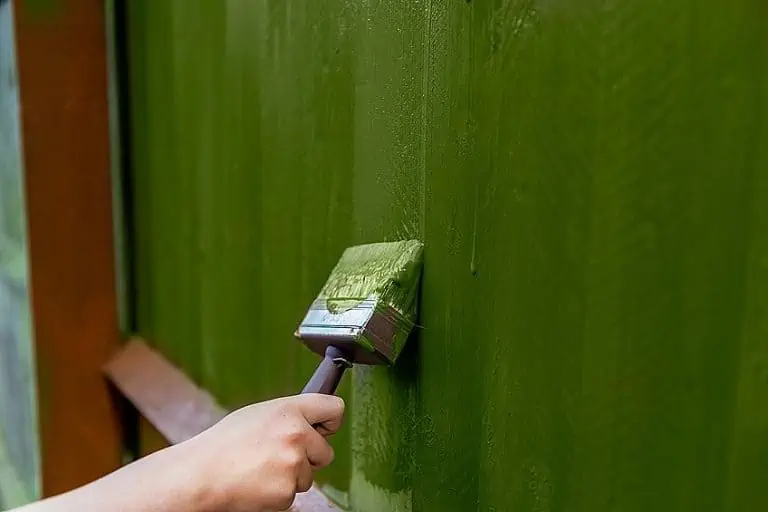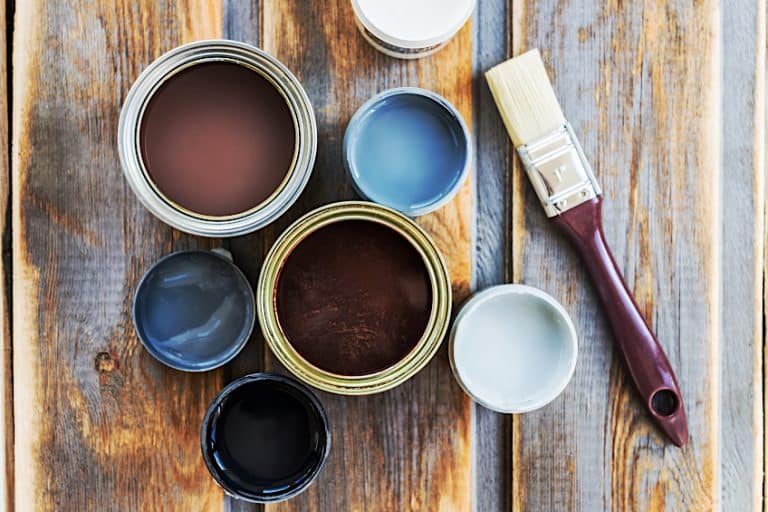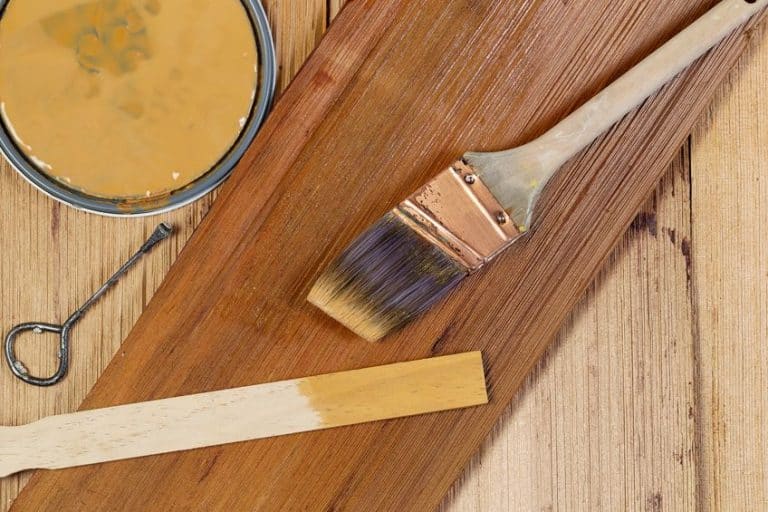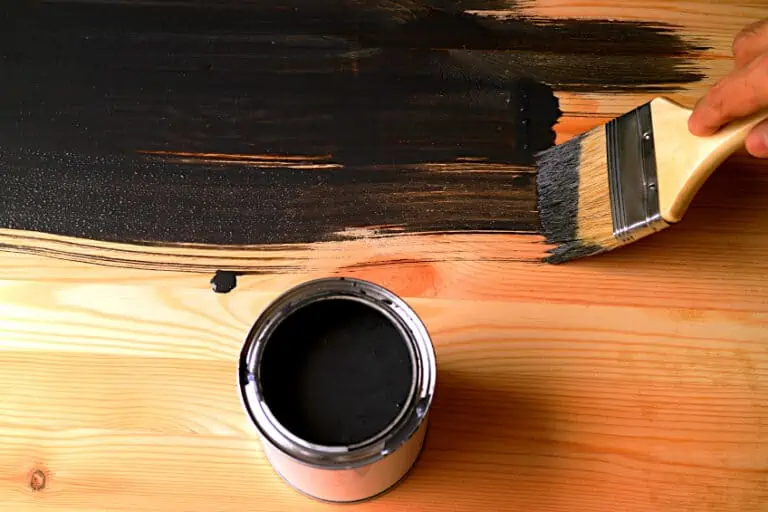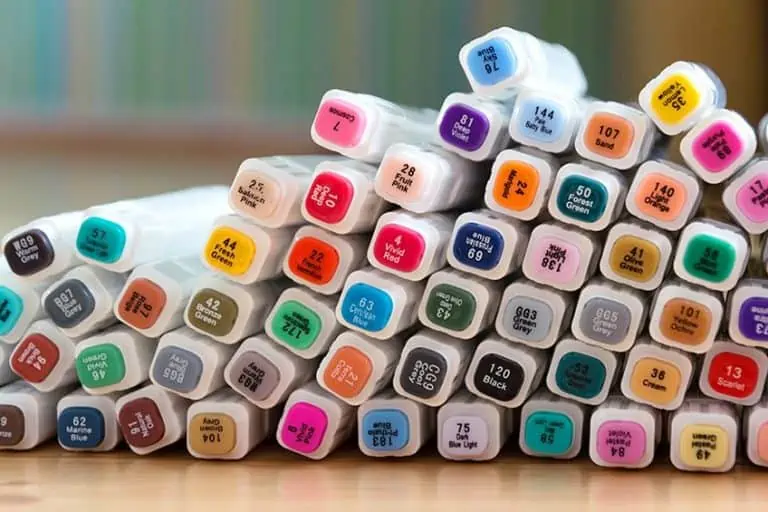How to Paint Veneer Furniture – Prepare, Paint, and Seal Veneered Wood
These days, there are loads of materials for you to choose from when finishing your home. There are all-natural materials like woods and metals, and then there are completely synthetic materials that are often cheaper and more robust. One of these materials is wood veneer, which has been used in various industries to create affordable and environmentally sustainable workpieces which can be just as good as solid wood. Although finishes using this material are vast and can even be custom-made, there is a chance that you might want to paint veneer. Can you paint over veneer though? What exactly is veneer? Let’s have a look at these questions and what products are available for finishing your veneered furniture to suit your personal style.
Table of Contents
What Is Wood Veneer?
What is wood veneer? This is a great question. Veneer is all over the place, in your home, in schools, offices, and is a crowd favorite among contractors and DIY home enthusiasts alike. What exactly is it though? There are loads of ways to describe what veneer is, but the most accurate description is that it is extremely thin pieces of wood that have been layered on top of one another and/or in sequence to create an aesthetically pleasing surface for various workpieces.
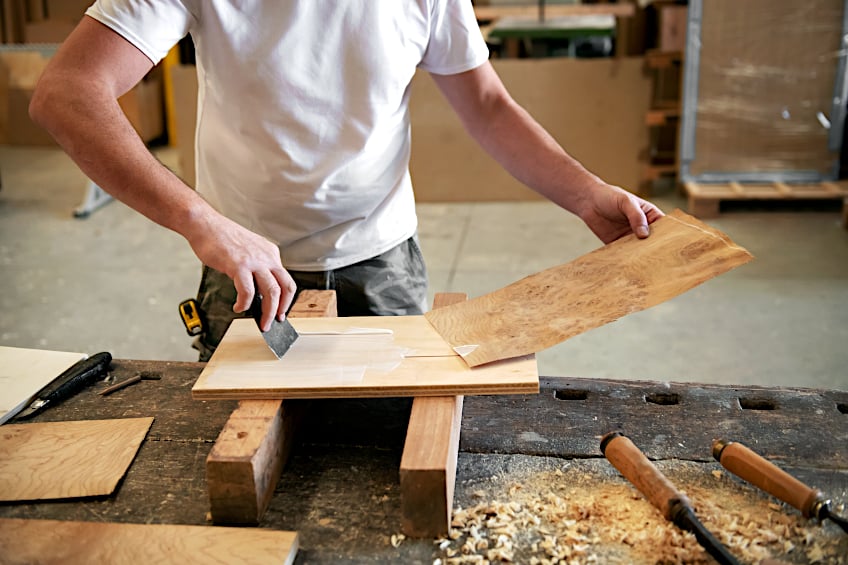
These pieces of wood are practically paper-thin, being around three millimeters thick which allows them to be placed on top of solid surfaces like doors, countertops, cupboards, desks, chairs, entertainment units, and even beds! Why would you place these wood pieces on top of an existing surface though? Well, they were originally designed as a cheap alternative to solid wood as they present the illusion of solid wood furniture.
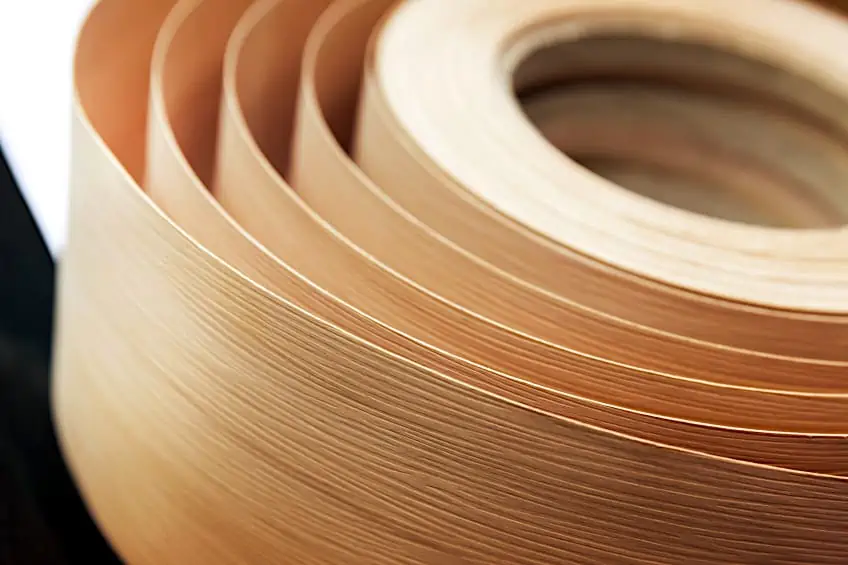
While veneer was initially seen as a rather cheap way to decorate one’s home, this notion has since fallen away, and veneer can be seen in even the most exclusive high-end homes. This is because the advantages of veneer far outweigh the cons. Veneer is easier to source, easy to install on essentially any surface, and it protects your surfaces from things like heat damage, moisture damage, impact, abrasion, and even insect infestations.
Keep in mind that it’s also a lot easier and far less expensive to replace and veneer finish than it is to resurface, sand, stain, and/or paint a solid wood furnishing. In fact, it’s not uncommon for older pieces of furniture that are beyond repair to be replaced with veneer finishes because they are cheaper to install and don’t require a fraction of the maintenance that solid wood furnishings do.
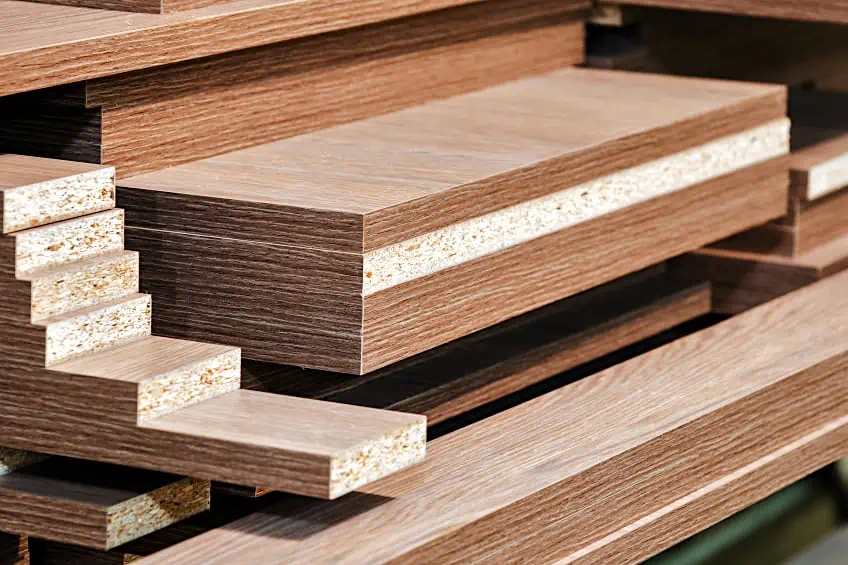
There are also various types of veneer. Veneer can be paper-backed, laid on top off of one another to create a solid piece of wood, and even used as backing for other veneer pieces. Commonly, veneer is used as a trim for either the surface of a workpiece or the edges, such as countertop edges or the sides of armchairs. In addition to all of the versatility associated with this material, it’s also really easy to apply to a surface, all you need is an adhesive graded for use with it and you’re good to go!
How to Tell if Furniture Is Laminate or Veneer
Wondering how to tell if furniture is laminate or veneer? As we mentioned previously the primary purpose of veneer is to create the illusion of solid wood finish, and while the presence of veneer on the surface might be obvious in some cases, a really good crafter might be able to trick your eye into believing that a particular workpiece is made of solid wood when it is actually a veneer finish. This presents a problem as you could be overcharged for a workpiece if you are led to believe that it’s actually solid wood, so let’s have a look at some of the indicators that a surface is actually made of veneer and not solid wood.
Weight
While veneered furniture might be designed to look like solid wood, one of the key factors that will allow you to differentiate between the two is the sheer weight that solid wood furnishings have. If you remember some basic physics, the denser an object is the more weight it will have, and since veneer tends to have less overall density compared to solid wood it is significantly lightened compared to its solid wood counterparts.

Why is veneer less dense compared to solid wood you ask? Well, wood tends to form naturally and therefore it needs to be super dense to support the weight of the tree and branches it forms a part of. Veneer on the other hand does not form naturally, instead it is manufactured by compressing multiple sheets of veneer on top of one another and gluing them together with epoxy or similar industrial-grade adhesives.
Grain
One of the things that makes solid wood such a sought-after material in the furniture and home improvement markets is the feel of the grain. This is often a highly textured natural aesthetic that follows the length of the surface of the workpiece. This grain can either be smooth or raised, and adds a dimension of aesthetic intricacy to any wooden workpiece, although it’s also hard to maintain and can be damaged easily.
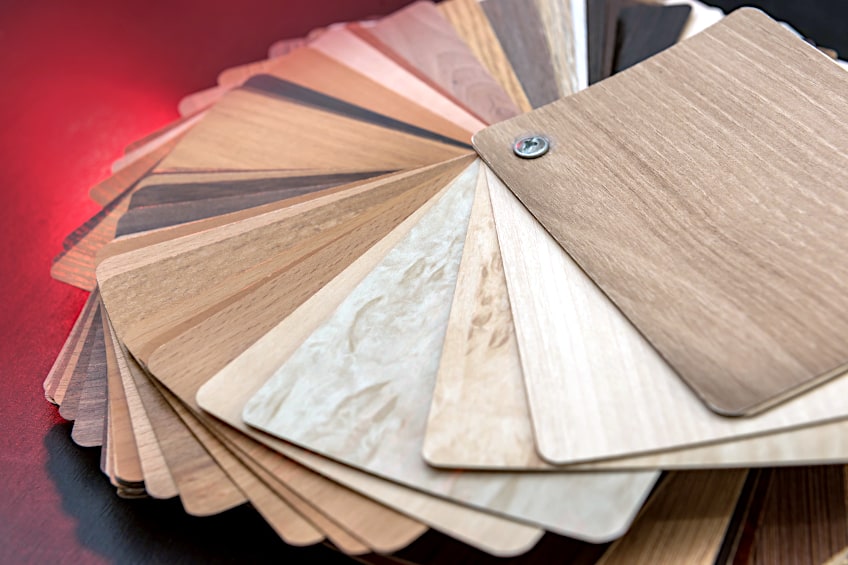
While one might think that grain is a given when dealing with any wood, natural grain is exclusive to solid wood, and it is the only one that has a tangible texture. This is one of the key indicators that the wood you’re dealing with is veneer. If the surface is smooth, and the grain of the wood doesn’t line up correctly, this is a dead giveaway that you’re dealing with veneer.
Uniformity
One of the things that makes a wooden workpiece one of the most valued items to own is the look and exclusivity that comes along with it. Wood is not a perfect medium though, and working with can be tough, especially when you’re trying to form it into a specific shape. This means that if a surface looks a bit too perfect the chances are that you are dealing with veneer and not solid wood.
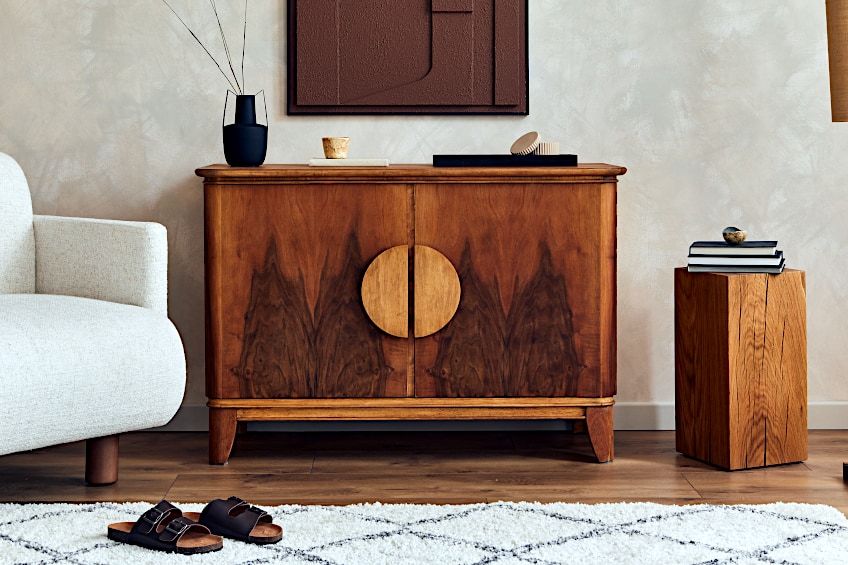
This isn’t a bad thing considering that most people are looking for a smooth, seamless surface, but you should watch out for those trying to pass off veneer as real wood. Another dead giveaway is the lack of fasters or locking mechanisms like screws and nails. While most workpieces won’t have them on the surface, they will be at the bottom or around the edges. Veneer workpieces will not have any of these present.
Banding
If you have ever worked with or owned a solid wood workpiece then you know that the edges are rounded either as part of the design or through wear and tear over time. It’s very rare to find a solid wood workpiece that’s edges are perfectly straight at a 90-degree angle due to the wood toward the edge of solid wood furniture being just that much softer and exposed to passers-by.
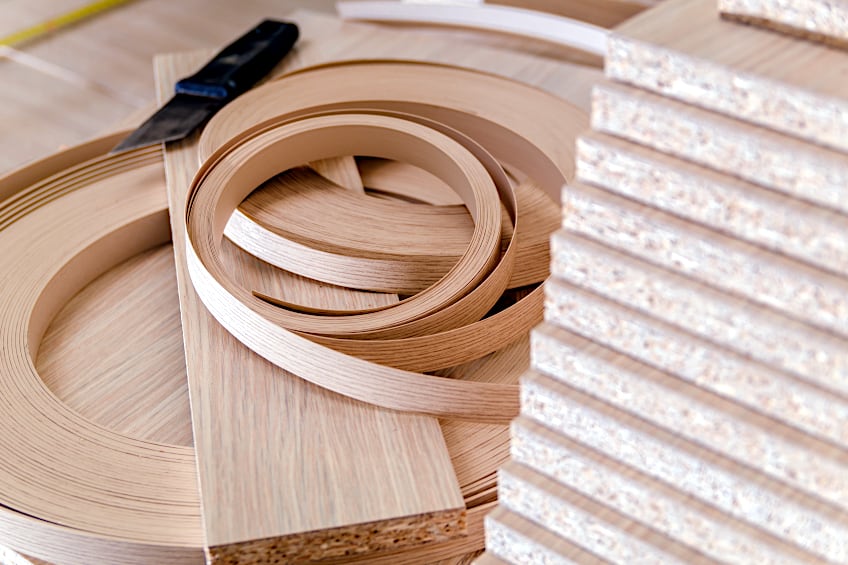
A good sign that a workpiece is made of veneer is that the edges will likely be at a seemingly perfect angle. This is because instead of a uniform piece of wood that has been cut to an edge, veneer workpiece consists of a surface covering and a band that surrounds the edges of the workpiece. This might not be immediately apparent, but with a closer look, you should be able to tell the difference.
Asking
What is the best way to determine if a workpiece is made of wood or veneer? Asking! Even if you don’t want to come across as ignorant or want anyone to know that you’re a newcomer, the crafting and woodworking communities are always happy to help. After all, we’re all here to do the best work we can, so there’s no shame in asking someone for confirmation.

You don’t just have to ask people on online forums either, if you’re out to buy some wood or are about to purchase a piece of furniture there are loads of local woodworking and craft professionals who are always willing to lend a hand. This way you know exactly what you’re getting and won’t be overcharged for something that’s a dime a dozen.
What Type of Paint Works on Veneer?
| Type Of Paint | Does It Work on Veneer? |
| Oil-Based Paint | ✔ |
| Chalk Paint | ✔ |
| Latex-Based Paint | ✘ |
| Acrylic Paint | ✔ |
| Lead Paint | ✘ |
| Metalized Dye Paint | ✘ |
| Enamel Paint | ✔ |
Oil-Based Paints
Oil-based paints are a great choice for painting virtually any surface you can think of. Not only are their colors vibrant and full of shine, but they also protect any wooden workpiece they’re used on from things like rot, mold, impact, abrasion, insects, heat, and moisture. Oil-based paints can be a bit expensive though and they’re frowned upon because they contain volatile organic chemicals (VOCs).
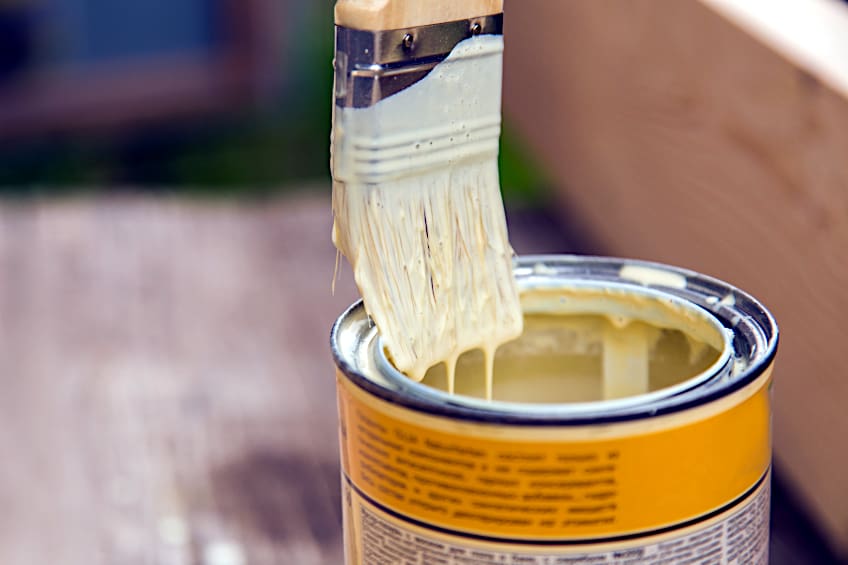 Oil-Based Paint for Veneer Furniture” width=”848″ height=”565″>
Oil-Based Paint for Veneer Furniture” width=”848″ height=”565″>
Can you paint over veneer with oil-based paint? Yes! There is a slight drawback to using oil-based paints on wood though. Because these paints are designed to soak into the wood’s fibers it can have some difficulty adhering to the surface. There is an easy workaround though, all you need to do is sand the surface with fine-grit sandpaper and apply a primer before using this type of paint on your workpiece.
Chalk Paint
This is one of the most popular choices for painting on veneer surfaces. Chalk paints are most commonly used in an aerosol form which makes them easy to apply. This type of paint has a dusty, muted tone to it once it’s been fully cured. This is a great finish for wood and ensures that all of your veneer workpieces have a unique, light aesthetic that is sure to impress.
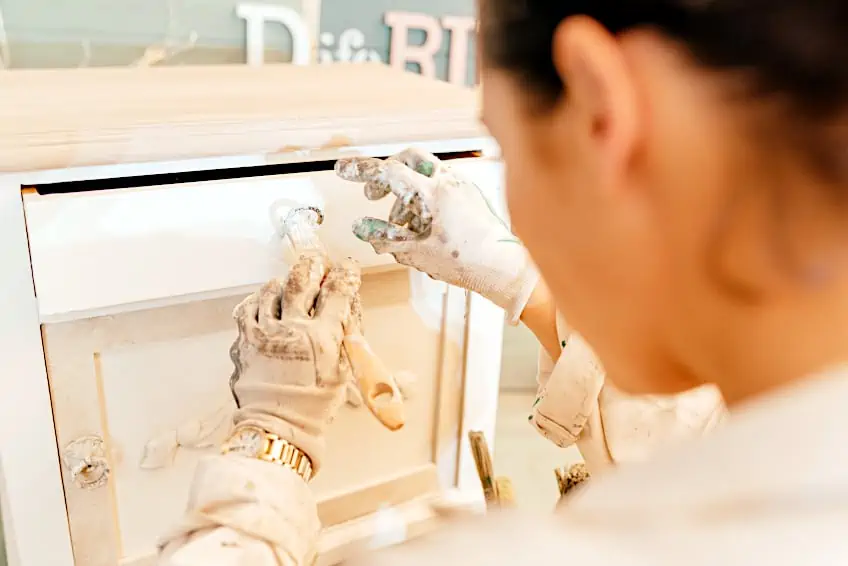
Why is chalk paint such a popular choice when painting veneer furniture? Well, it’s one of the few paint types that require little to no preparation when being applied to surfaces with low surface friction. This means very little sanding and no primer is needed, plus, some chalk paints are self-priming in case painting veneer furniture gets a bit tougher than your expected.
Acrylic Paint
Acrylic paint is the weapon of choice for many modern crafters and DIY enthusiasts. Why? It is readily available and can be used on most surfaces. It’s also not as permanent as oil-based paints but they do provide nearly the same finish and an even larger color variety. Acrylic paints work well on veneer surfaces and produce far fewer VOCs.
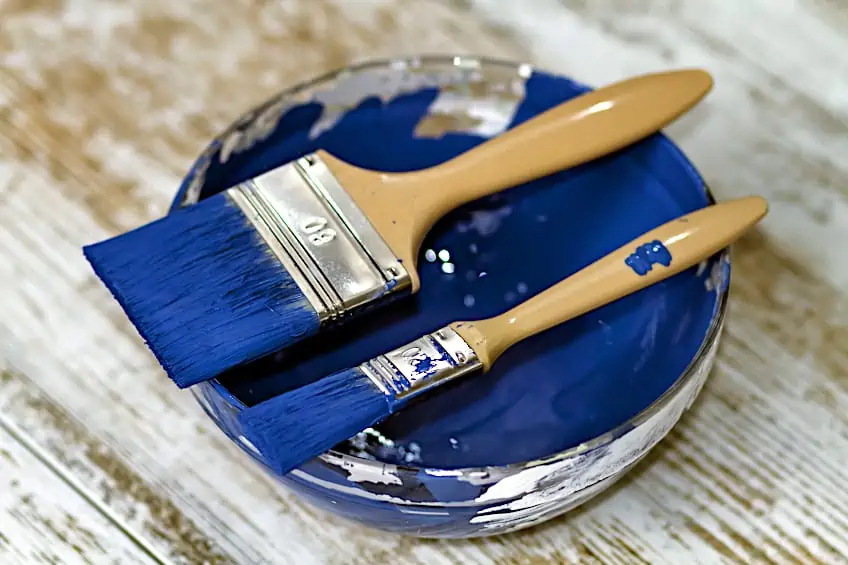 Acrylic Paint for Wood Veneer” width=”848″ height=”565″>
Acrylic Paint for Wood Veneer” width=”848″ height=”565″>
Acrylic paint is one of the best types of paint to use on veneer surfaces because it doesn’t need to absorb into the wood fibers of the veneer board for it to adhere correctly. Although this is great for painting veneer, it does mean that you will need to lightly sand and primer your surface in order to use this type of paint.
Enamel Paint
While enamel paint is usually reserved for the interior of homes, it can be used to achieve an impressive finish on both interior and exterior furniture too. This paint air dries to a smooth muted finish that works on nearly any furniture, and it protects your workpieces by forming a relatively thick coating of paint.
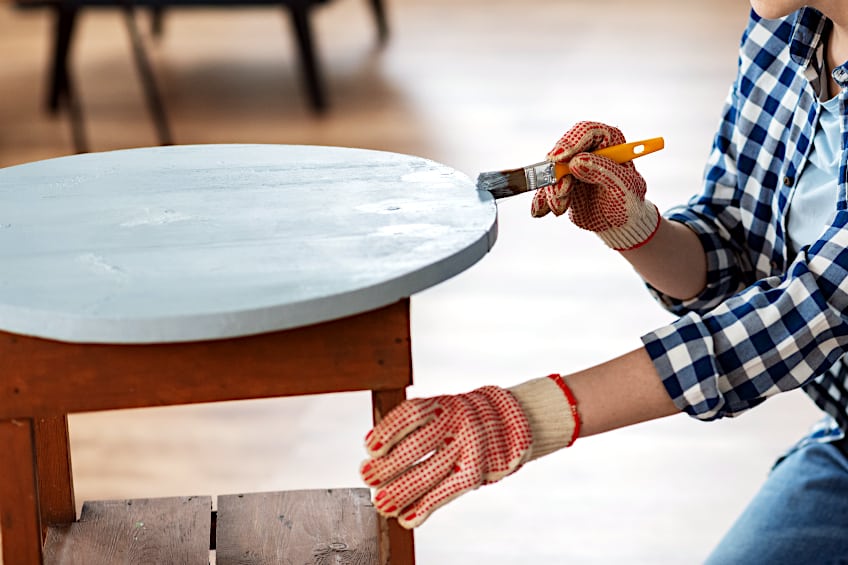
This paint is typically available in loads of fun pastel colors and since it’s readily available you won’t have to look around too much to find one that you like. Depending on whether your veneer has a laminated finish, you might not even need to prime your surface! This means that you can spend less time preparing and more time painting your workpiece.
How to Paint Veneer Furniture
Now that you know which types of paintwork on veneer and what veneer, you’re probably wondering how to repair peeling veneer or how to paint over veneer entirely. This is why we have prepared a short tutorial detailing the best way to paint over veneer while ensuring that the paint adheres correctly, and the desired aesthetic is achieved.
Prepare Your Workspace
Preparing your workspace is one of the most important steps in any woodworking or crafting project. Why? It allows you to prepare all of your tools and arrange your workspace in a manner that will allow you to work efficiently. More importantly, though, it ensures that you are able to protect all of your surfaces from any potential damage.
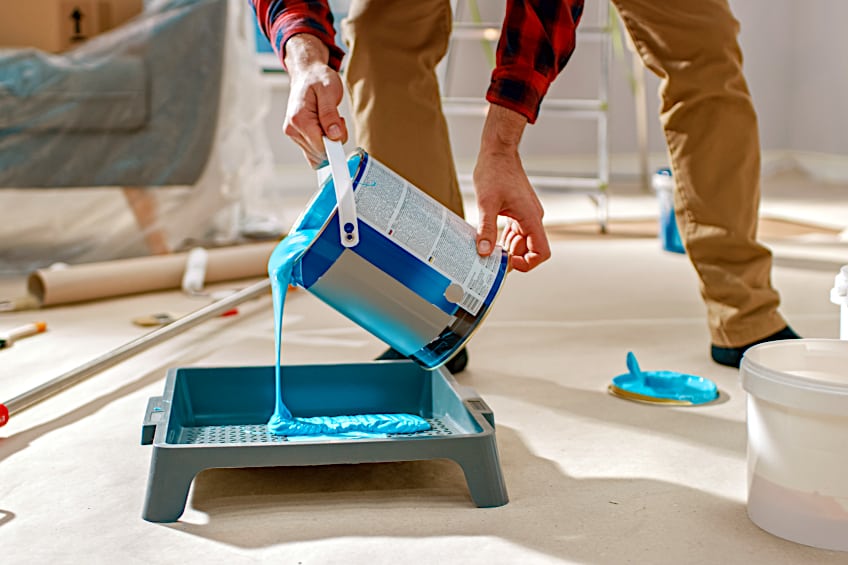
How do you do this? Well, you could start by laying down a tarp over the floor of your workspace and the top of your worktable (if you are working with a smaller workpiece). Next, secure your tarps with some painter’s tape which should prevent any paint or wood dust from getting underneath these coverings.
Finally, ensure that you are protected. When working with paints that contain VOCs or any workpiece that could expose you to fine particles of dust or wood it’s important to ensure that your workspace is as well ventilated as possible. Further preventative measures include wearing a face mask and a pair of gloves graded for use in woodworking to ensure your safety.

Prepare Your Workpiece
Now that your workspace has been prepared it’s time for you to prepare your veneer workpiece for painting. How do you do this? Pretty much the same way that you would prepare a solid wood workpiece only slightly more gently. Why would you do this? To ensure that you do not damage the structural material underneath the veneer, which could lead to a nasty dent in your workpiece.
You will need to sand the entire surface of your workpiece though, this includes the primary surface, your drawers, the legs, and any other minor surface with some fine-grit sandpaper. It’s best to use sandpaper with a grit of 120 and upward for this application as this won’t warm the veneer particularly if you’re using a power sander.
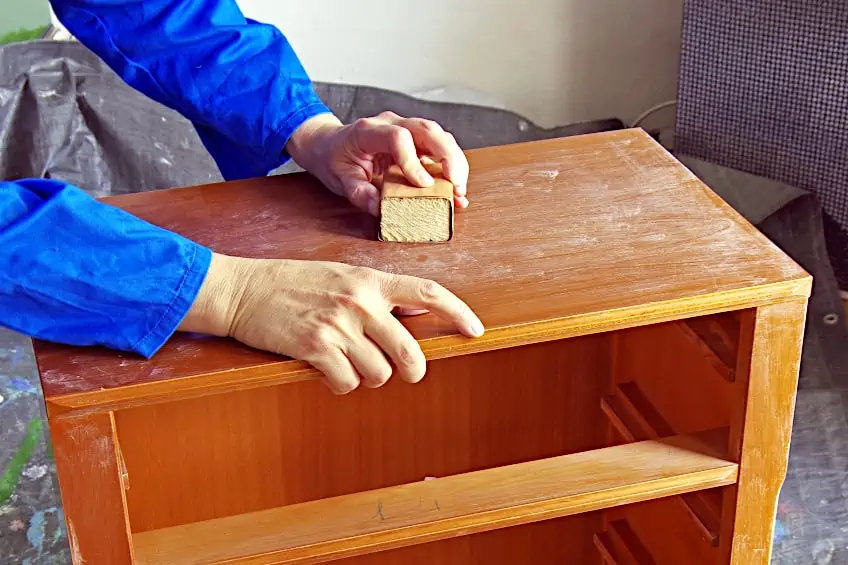
This is also why most crafters who work with veneer recommend using a sanding block as opposed to sanding paper or a power sander as it provides you with the leverage and speed you need without risking completely ripping the veneer to pieces. Why sand the surface of your workpiece? Veneer is pretty slippery, so the added surface fiction assists in the adhesion process of the paint.
Cover Important Areas
If you’re just painting your veneer tabletop, it’s important for you to cover up any areas of your workpiece that you don’t want to paint. This applies even if you’ll be painting certain parts of your workpiece a different color to the surface, all you need to do is apply painters tape the surfaces you don’t want to be painted and ensure that the tape has adhered properly to the sanded surface.
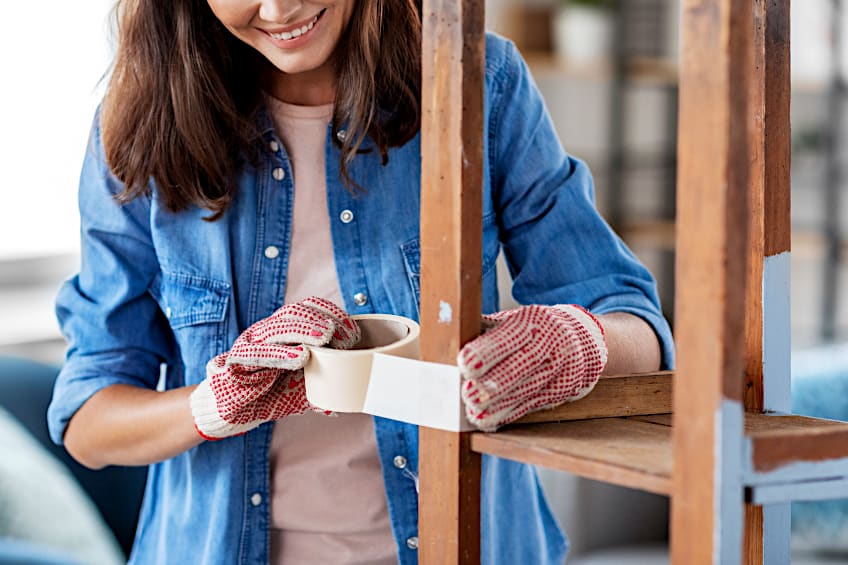
You should also remove any elements from the workpiece that you won’t be painting or that you would rather avoid paint getting on to. This includes little handles or metal accents that could be ruined by the paint you’re using. Other than these, you should also remove any drawers or exposed dowels if you’re only painting a part of a furniture piece.
Prime Your Workpiece
If this is your first rodeo painting furniture don’t worry, we’ve got your back. Primer is a substance that both allows the paint to adhere to a workpiece well and in some cases can even amplify the color of the paint being used. Primer is usually a white or opaque color depending on the type of paint it’s been designed for.
While aerosol primers are readily available, they tend to be a bit pricey. If you’re using one all you need to do is apply your primer evenly after giving the can a good shake, and then allowing the primer to dry for the manufacturer’s recommended time period. If you are using a conventional primer, here are a few steps to ensure you get the most out of it.
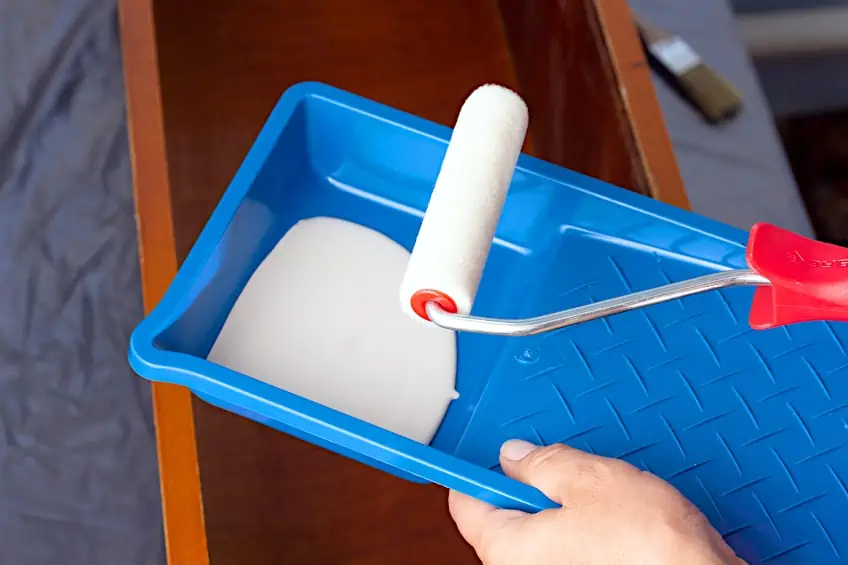
Give the can a good stir once it’s been opened up to ensure that all of the elements are evenly distributed after sitting at the bottom of the can for a long time. Once the mixture is ready pour some of the primer out into a paint tray and get your brush and/or roller ready. Dip the brush or roller and ensure that it has a decent amount on it before you get started.
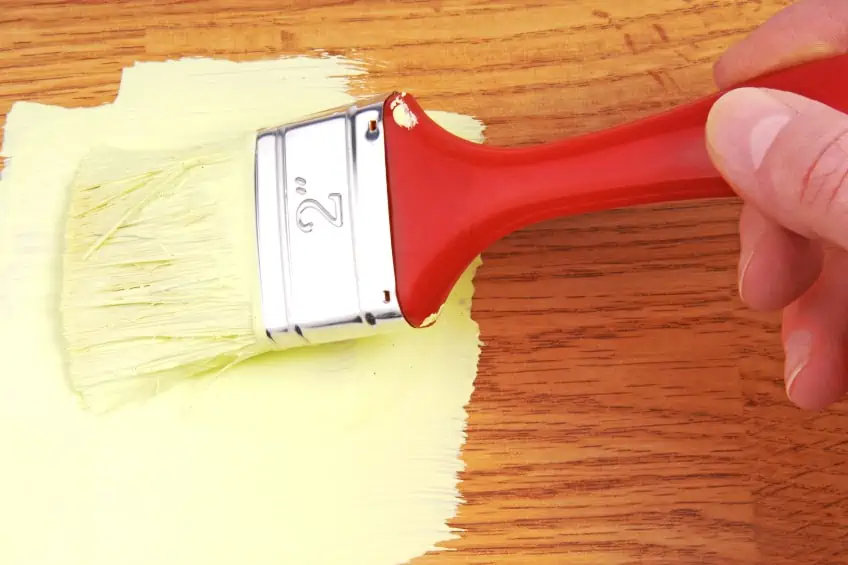
Prime all of the surfaces that you will be painting on this pass. The trick with priming it is to do it as if you were already painting the workpiece, you want as much consistent coverage as you can manage. It also helps to follow the grain of the veneer you’ll be painting to ensure that the primer adheres as best it can.
Once you’re satisfied with the application of your primer, allow it to dry for the manufacturer’s recommended time period before moving on to the next step in the process.
Paint Your Veneer Workpiece
Now for the moment you’ve been waiting for, finally painting your workpiece! To start, give your tin of paint a good stir. Just like the primer some of the heavier elements could have sunk to the bottom of the can over time, so giving it a good stir will ensure that the paint is well balanced once you apply it to your workpiece. Once it’s all mixed up, pour out some paint into a (clean) tray and get a brush and roller ready.
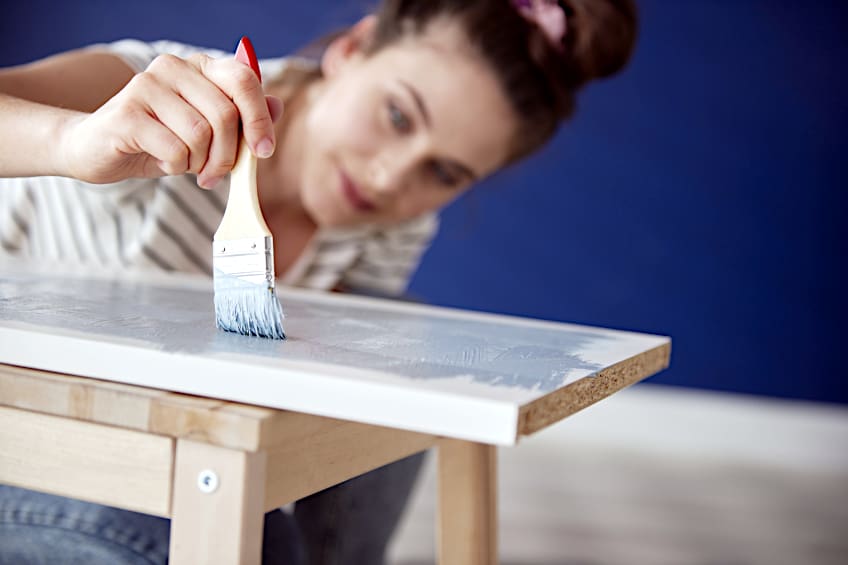
Once you have some paint on your brush or roller it’s time to get painting. If you’re working with a rectangular or conventionally shaped workpiece all you need to do is paint from one end of the board to the other, following the length of the grain. This is the ideal approach for painting a veneer tabletop but if you find yourself needing to paint an irregularly shaped workpiece like a round coffee table, we recommend painting from the center of your workpiece outward.
Depending on the brand of paint that you have selected and the size of your workpiece you might need to apply more than one coat of paint. If this is the case, ensure that you allow each coat of paint to dry for the manufacturer’s recommended time period before applying the next coat.
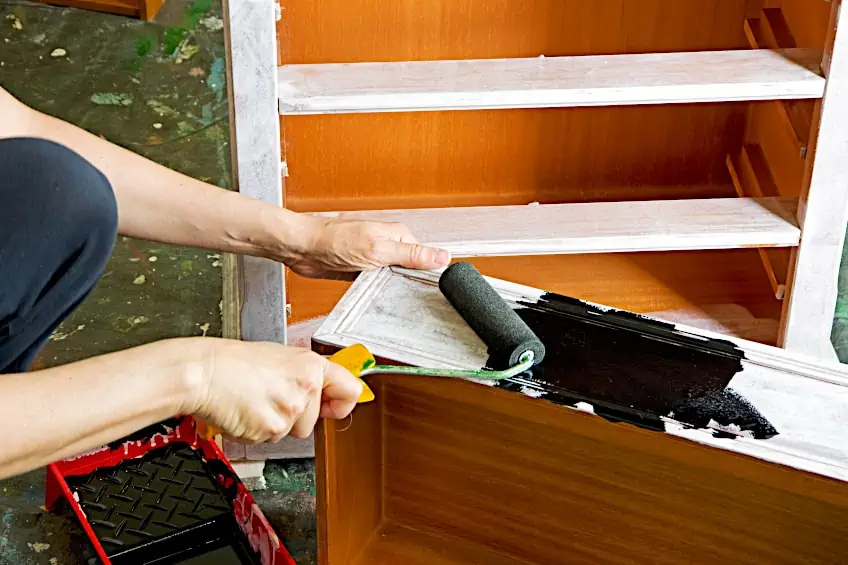
Once your final coat has been applied you have the option of adding a clear coat or resin coating to protect your workpiece from damage. Not only does this ensure that your finish will be protected from things like impact, abrasion, heat, and moisture, but it adds another dimension to the color of your paint.
Now that you know what veneer is, what types of paint work on veneer (and which ones don’t), as well as how to paint over a veneer finish, it’s time for you to get out there and put your new-found knowledge to the test. Remember to always work in a well-ventilated area and to always wear the appropriate personal protective gear when working with any substance that contains VOCs.
Frequently Asked Questions
How to Repair Peeling Veneer?
If you’re wondering how to repair peeling veneer, it’s a lot easier than you might think. Veneer is glued to solid structures in order to create the illusion of, or substitute for, solid wood paneling. This being said, veneer normally peels or lifts when the glue fails, so the best solution is to remove the remaining glue with some sandpaper and solvent and re-adhere the veneer with a superior glue.
Can You Stain Veneer?
Can veneer be stained? Yes! Although it might seem like it isn’t wood, veneer is still made of wood particles, just a lot thinner than solid wood surfaces. The only thing that you need to do is ensure that any protective coatings like resin or laminate are removed from the surface beforehand. This is easily done with some sandpaper.
Can You Fix Sanded-Through Veneer?
Can you fix sanded through veneer? While it might seem like the end of the world you can fix veneer that has been sanded through. The obvious solution is to sand carefully or by hand to avoid this problem, but in case you have already sanded through your veneer, you can fill and paint over the spot.

I have been into woodworking since 2005 and woodturning since 2011. Because of my love for wood and woodworking, I started woodhappen.com to teach other enthusiasts about how to finish and seal wood, the best woodworking tools, the different types of wood, and everything else related to woodworking! Read more about me here.

